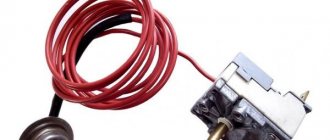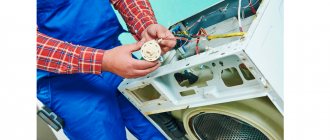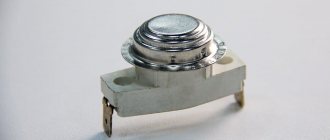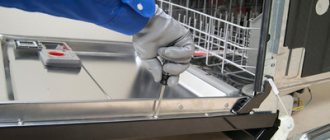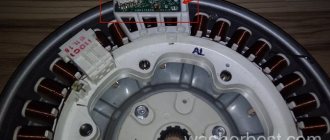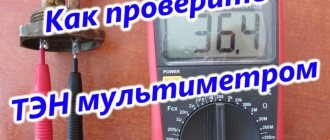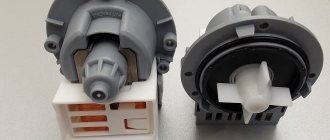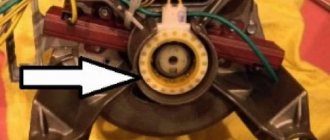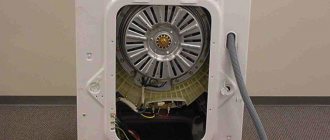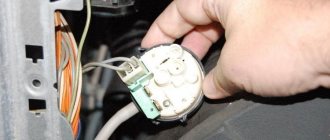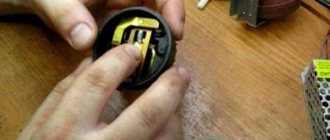To ensure proper operation and adherence to the specified washing regime, washing machines are equipped with many different sensors. The sensors carry the function of transmitting data to the main control module about the temperature and water level in the tank, engine rotation speed and other parameters of the entire operating mechanism of the product.
Based on the received sensor readings, the electronic unit controls the entire specified cycle of programs. The temperature sensor in the washing machine is one of the most important devices that informs the control unit about the state of the water temperature in the appliance tank. It is necessary to comply with the specified parameter to improve the quality of washing our clothes and avoid damage to them due to unacceptable excessive heat treatment.
Also, a thermostat for a washing machine is used to detect malfunctions of the heating element, pressure switch and possible incorrect connection of the washing unit to the communications necessary for its operation.
But like any part, the washing machine thermistor is subject to natural wear and tear as a result of inappropriate operating conditions.
A malfunction of the temperature sensor results in incorrect readings for the electronic unit or their complete absence. Modern machines are equipped with a system for recognizing their faults and react to the breakdowns of their parts and catches, or the reasons for which they are caused. Timely replacement of a faulty thermostat is necessary mainly to avoid damage to things from possible temperatures exceeding those allowed for a given type of fabric.
Where is the thermostat located and how does it work?
In most models of washing machines, the thermistor is located in the heating element and has a cylindrical shape with a circumference of 10 mm.
In some washing machines, the thermistor can be installed separately from the heater directly in the tank in a place provided by the design, and have the shape of a tablet with a diameter of 25-30 mm.
It directly contacts one part with the water in the tank to obtain an indication of the existing temperature of the liquid. Wires are connected to the second, outer part of the sensor, transmitting readings from the electronic component to the electronic unit.
Electronic temperature sensors transmit data to the control unit in the form of resistance readings, which change depending on the level of water heating. The processor converts sensor resistance readings into temperature parameters and controls the timely shutdown of the heater.
Older machines were equipped with gas thermostats. They were made in the form of a thin metal tube with gas, on one side of which there was a tip in contact with water, and on the other a temperature regulator.
The power supply to the heating element in such a sensor was turned off due to a change in pressure when the water was heated. These thermostats had a rather complex design and were subsequently replaced by their electronic counterparts, which had a simple design and the lowest cost.
Diagnostics and replacement of temperature sensors
Washing machine thermostat replacement tool:
- Phillips screwdriver;
- flat screwdriver;
- 10 mm socket wrench;
- tester;
- waterproof glue or silicone.
To replace the thermostat in your washing machine, you need to find out where the thermostat is installed. On most models it is located under the back cover along with the heating element (at the bottom of the drum). But, for example, on Bosh and Siemens machines the thermostat is located behind the front panel, and to dismantle it you need to remove the top and front panels. The installation location of the temperature sensor on your machine can be clarified in documents or on the Internet.
Replacing a gas-filled thermostat
Sequence of operations:
- disconnect the machine from the network;
- drain the water from the tank;
- unscrew the screws and remove the cover;
- loosen the heating element fastening with a key;
- take a photo of the connection diagram before removing the power wires from the thermostat;
- carefully remove the thermostat with a flat screwdriver, being careful not to damage the rubber seal;
- remove the temperature regulator from the control panel;
- inspect the installation site and, if necessary, treat with sealant or glue;
- Install the new thermostat in reverse order;
- turn on the machine and check the operation of the thermostat in heating mode up to 40 degrees.
Replacing a bimetallic thermostat
Subsequence:
- disconnect the machine from the network;
- drain the water from the tank;
- remove the cover;
- loosen the heating element fastening with a key;
- take a photo of the connection diagram before removing the power wires from the thermostat;
- remove the thermostat;
- measure resistance with a tester at room temperature;
- Place the thermostat in hot water and measure the resistance again. If the measurement result does not change or changes slightly, the sensor should be replaced;
- installing the thermostat is done in the reverse order;
- turn on the machine and check the operation of the thermostat in heating mode up to 40 degrees.
Replacing the thermistor
- disconnect the machine from the network;
- drain the water from the tank;
- remove the cover;
- loosen the heating element fastening with a key;
- take a photo of the connection diagram before removing the power wires from the thermistor;
- remove the thermistor, measure the resistance with a tester and compare with the nominal value for a given machine model;
- install and connect the new thermistor in the reverse order;
- turn on the machine, check the operation of the thermistor in heating mode up to 40 degrees.
Attention! All work should be carried out only after disconnecting the machine from the network!
How to check the temperature sensor of a washing machine
If the washing machine begins to behave differently than usual, namely:
- Takes a long time to wash;
- To the touch when washing, the sunroof glass remains cold or very hot (not according to the set temperature);
- The program crashes and an error code appears on the display;
- After washing, poor quality of dirt removal was revealed; then you need to check the thermostat for proper operation;
- To do this you need to determine where it is. It is best to dismantle it from the installation site and check it outside the machine.
This is done differently in different models of washing machines, but the principle is the same in all cases:
- LG machine. Remove the back cover of the product. The temperature sensor in the lg washing machine is located either in the heater itself or in the tank to the left of the heating element. To dismantle it, you need to loosen the spiral mounting nut, remove the wires from the thermostat and pull it towards you. Set the multimeter to measure resistance on a 200 kOhm scale. Take measurements at room temperature. Touch the sensor contacts with the probes. The resistance of the go should be approximately 50 kOhm.
- After this, I do not remove the probes from the contacts and lower the sensor into preheated water. The sensor resistance should change smoothly without interruptions in the readings on the tester screen (the readings should not disappear). If the readings disappear or are absent at all, then the sensor must be replaced with a new one;
- Washing machine Indesit. Remove the back cover of the machine. The sensor is located in the heater. Loosen the heating element and remove the sensor from it, having first disconnected the wiring from it.
- The readings of a working sensor at room temperature are approximately 20 kOhm. When it is heated in hot water, the readings will decrease;
- Bosch washing machine.
Common breakdowns
Most often, in these sensors, the copper tube, which acts as a freon conductor, fails. As a result, the functionality of the sensor is impaired, and the part has to be replaced with a new one. Having purchased a new spare part, install it in place of the failed one.
External signs of problems with the sensor can take the following forms:
- washing with any mode and arbitrarily selected temperature is still carried out in boiled water;
- The external panels of the washing machine become very hot during operation, and steam may billow from the loading hatch.
The presence of these signs means an urgent need to replace the heating control device. Further operation of the machine with a non-functioning sensor can lead to serious damage to the entire system or burnout of the heater. Replacing a failed heating element will be quite troublesome and expensive.
How to ring a heating element with a multimeter
If the readings of the temperature sensor turned out to be correct when checking it, and the washing machine still washes in cold water, then the heating element needs to be checked with a multimeter. It is quite simple to check the heating element with a tester; to do this, you need to remove the wires from it, set the multimeter to measure the minimum resistance and ring the heater contacts with probes.
The resistance of the water heater should be 25-35 Ohms. Afterwards, you need to check for a possible breakdown in the housing.
To do this, set the multimeter to the maximum resistance measurement values, touch any of the contacts of the part with one probe, and its body with the other.
With an intact case, the resistance on the tester will be equal to unity. To check the heating element for breakdown of the housing, it is necessary to first keep it in water for some time; a dry heater can show positive measurement results.
A faulty heater must be replaced to ensure proper operation of the washing machine and to avoid electrical shock to users of the appliance. Most modern washing machines recognize a breakdown that occurs on the body of the washer and turn off the program.
Also, if there is an RCD in the power supply circuit of the washing machine, then this device completely de-energizes the outlet at the slightest breakdown of electricity on the product body. This can also occur due to the use of electrical appliances in poorly ventilated areas or in high humidity.
Types of thermostats
According to their design, all thermostats used in washing machines can be divided into 2 groups:
- Electromechanical (bimetallic, gas-filled);
- Electronic (thermistors).
The first includes two types of thermostats, using different physical media, but based on the same principle - opening the electrical circuit at a certain temperature. Bimetallic devices are two plates fastened to each other, having different coefficients of thermal expansion. When heated, they bend and open the electrical contacts in the heating element’s power circuit.
Gas-filled thermostats use freon, which, when heated, increases in volume and puts pressure on a special membrane, which also opens or closes the contacts of the electrical network. There are electromechanical thermostats with a fixed or continuously adjustable response temperature.
Electronic thermistors are used in the most modern washing machines. The principle of their operation is based on the dependence of the semiconductor resistance on its temperature. A decrease in the resistance of the sensor is perceived by a special controller as heating the water, and at certain indicators it gives a command to turn off the heating element.
Reasons for failure of temperature sensors
The main causes of thermostat failures are:
- Frequent washes at high temperatures. Such temperature conditions affect the rapid wear of many parts of washing machines, and also negatively affect the quality of the fabrics of the washed items. Modern detergents are quite effective in removing stains even at low washing temperatures;
- Unstable voltage in the power supply network. Voltage fluctuations have a detrimental effect on any electronic components, and short circuits instantly damage them. To use a washing machine, it is best to install a separate electrical wiring line from the meter of your home.
- The wires must have a sufficient cross-section to avoid overheating of the insulation. The device must be grounded. For your own safety, you need to install an RCD (residual current device).
- How is blood washed off?
- How to wash membrane clothes
Self-repair: what to do
If F38 is lit on the display, before starting self-repair, try to clear the error by rebooting the machine:
- Disconnect the Bosch automatic washing machine from the power supply by unplugging the plug from the socket.
- Leave for 10-20 minutes.
- Turn on the washer.
If the error reset was successful, perhaps there was no failure, the control unit simply malfunctioned. But if error codes, in particular F38, appear again, then a major repair is required.
At best, you will have to carry out a minor repair by replacing the temperature sensor. At worst, the electronic module will need to be replaced. Let's start with the simple one - replacing the temperature sensor.
